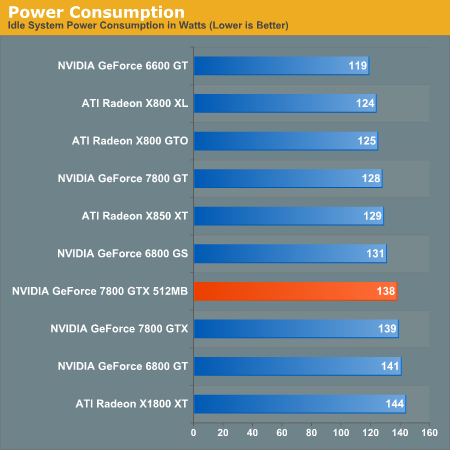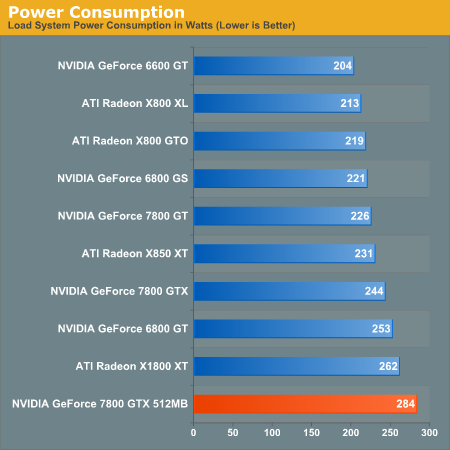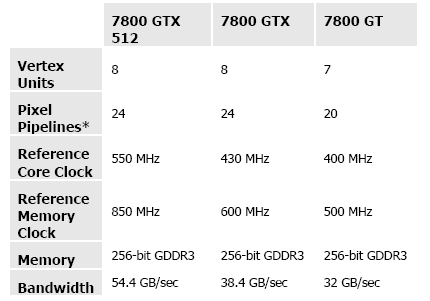NVIDIA GeForce 7800 GTX 512: More Than Just More Memory
by Derek Wilson on November 14, 2005 9:00 AM EST- Posted in
- GPUs
The Card, The Test, and Power
There are a few key changes from the original 7800 GTX silicon that allow the 7800 GTX 512 to perform so highly. The 7800 GTX 512 still uses a 110nm process like the original 7800 GTX, but NVIDIA has tuned their fab process to speed up key data paths in the chip. These enhancements, while not altering the feature set in anyway, allow the chip to reach clock speeds of 550MHz (which is 120MHz faster than the original 7800 GTX). On top of changes in the silicon, the 7800 GTX 512 has gotten a PCB revision. And just in case anyone is wondering, the huge HSF solution is actually very quiet. NVIDIA is using a fan with larger blades that move a good volume of air without needing to run at super high RPMs. While it may look like an industrial sized leaf blower, it bark is certainly nothing compared to the bite this thing takes out of our performance tests.
Current 7800 GTX cards feature 8Mx32 GDDR3 with four chips on each side of the PCB. Most cards have a heat spreader on the back of the board, while some vendors have attached heatsinks. NVIDIA needed a better way to cool their RAM in order to hit the memory clock speeds they wanted. To this end the 7800 GTX 512 sees all of its RAM on the front of the PCB cooled by the very large heatsink previously employed on the Quadro FX 4500. Moving all the RAM to one side of the PCB may also have improved the routing to certain memory modules, which would also help increase attainable stable memory clock speeds. There are still only 8 modules total, as NVIDIA has also moved to higher density 16Mx32 GDDR3. The RAM used is also rated at 900MHz (1800MHz data rate), giving the stock memory clock speed of 1700MHz a little head room for vendors who like to overclock the cards they sell.
Here is a quick comparison of NVIDIA's 7800 series line up with the new GTX 512:
Slower architectures have the advantage of being less effected by latency as a long clock cycle time allows data to move further per cycle. At the same time, to compete with high frequency processing, much more work has to get done per clock cycle than a faster chip. Graphics tend to lend themselves to this type of architecture, which is partly why we haven't seen multiple-GHz graphics chips.
In any case, increasing core and memory clocks, framebuffer size, and adding a gigantic HSF will certainly require a little more power than the standard 7800 GTX. NVIDIA currently still recommends the same types of power supplies for the 7800 GTX 512 as it does for the 7800 GTX, but, as we can see from our tests, the 7800 GTX 512 does result in a much higher power draw from the wall. In fact, the outlets in our lab had some trouble getting consistent power to our PSU during SLI testing. Most people won't run into a problem like this unless they run quite a few PCs off the same circuit breaker at home. We actually had to solve our problem by running one of the 7800 GTX 512 cards off of a second power supply plugged into an extension cord running off of a different circuit. If nothing else, this setup could help people test for wiring problems in their homes.
These power numbers are measured at the wall before the PSU.


Certainly the 7800 GTX 512 is a power hog to say the least. Unfortunately, we didn't have a reliable way to test power draw for the 7800 GTX 512 SLI setup, but if we ever get around to rewiring the lab ...
Let's take a look at the hardware we will use.
Test Hardware
This is definitely a powerful system we will be examining today. For our benchmarks, we test with sound disabled. Most of these tests are timedemos played back using ingame functionality, but the Black & White 2 benchmark is a FRAPS test using an ingame cut scene. We will provide bar graphs for the very popular 1600x1200 resolution while reporting data from 1280x960 to 2048x1536 in resolution scaling graphs.
There are a few key changes from the original 7800 GTX silicon that allow the 7800 GTX 512 to perform so highly. The 7800 GTX 512 still uses a 110nm process like the original 7800 GTX, but NVIDIA has tuned their fab process to speed up key data paths in the chip. These enhancements, while not altering the feature set in anyway, allow the chip to reach clock speeds of 550MHz (which is 120MHz faster than the original 7800 GTX). On top of changes in the silicon, the 7800 GTX 512 has gotten a PCB revision. And just in case anyone is wondering, the huge HSF solution is actually very quiet. NVIDIA is using a fan with larger blades that move a good volume of air without needing to run at super high RPMs. While it may look like an industrial sized leaf blower, it bark is certainly nothing compared to the bite this thing takes out of our performance tests.
Current 7800 GTX cards feature 8Mx32 GDDR3 with four chips on each side of the PCB. Most cards have a heat spreader on the back of the board, while some vendors have attached heatsinks. NVIDIA needed a better way to cool their RAM in order to hit the memory clock speeds they wanted. To this end the 7800 GTX 512 sees all of its RAM on the front of the PCB cooled by the very large heatsink previously employed on the Quadro FX 4500. Moving all the RAM to one side of the PCB may also have improved the routing to certain memory modules, which would also help increase attainable stable memory clock speeds. There are still only 8 modules total, as NVIDIA has also moved to higher density 16Mx32 GDDR3. The RAM used is also rated at 900MHz (1800MHz data rate), giving the stock memory clock speed of 1700MHz a little head room for vendors who like to overclock the cards they sell.
Here is a quick comparison of NVIDIA's 7800 series line up with the new GTX 512:

Slower architectures have the advantage of being less effected by latency as a long clock cycle time allows data to move further per cycle. At the same time, to compete with high frequency processing, much more work has to get done per clock cycle than a faster chip. Graphics tend to lend themselves to this type of architecture, which is partly why we haven't seen multiple-GHz graphics chips.
In any case, increasing core and memory clocks, framebuffer size, and adding a gigantic HSF will certainly require a little more power than the standard 7800 GTX. NVIDIA currently still recommends the same types of power supplies for the 7800 GTX 512 as it does for the 7800 GTX, but, as we can see from our tests, the 7800 GTX 512 does result in a much higher power draw from the wall. In fact, the outlets in our lab had some trouble getting consistent power to our PSU during SLI testing. Most people won't run into a problem like this unless they run quite a few PCs off the same circuit breaker at home. We actually had to solve our problem by running one of the 7800 GTX 512 cards off of a second power supply plugged into an extension cord running off of a different circuit. If nothing else, this setup could help people test for wiring problems in their homes.
These power numbers are measured at the wall before the PSU.


Certainly the 7800 GTX 512 is a power hog to say the least. Unfortunately, we didn't have a reliable way to test power draw for the 7800 GTX 512 SLI setup, but if we ever get around to rewiring the lab ...
Let's take a look at the hardware we will use.
Test Hardware
| CPU: | AMD Athlon 64 FX-57 (2.8GHz) |
| Motherboard: | ASUS A8N32-SLI Deluxe |
| Chipset: | NVIDIA nForce4 SLI X16 |
| Chipset Drivers: | nForce4 6.82 |
| Memory: | OCZ PC3500 DDR 2-2-2-7 |
| Video Card: | ATI Radeon X800 XL ATI Radeon X1800 XT ATI Radeon X850 XT NVIDIA GeForce 6800 GS NVIDIA GeForce 7800 GT NVIDIA GeForce 7800 GTX NVIDIA GeForce 7800 GTX 512 |
| Video Drivers: | ATI Catalyst 5.11 (WHQL) NVIDIA ForceWare 81.89 (Beta) |
| Desktop Resolution: | 1280x960 - 32-bit @ 60Hz |
| OS: | Windows XP Professional SP2 |
| Power Supply: | OCZ PowerStream 600W PSU |
This is definitely a powerful system we will be examining today. For our benchmarks, we test with sound disabled. Most of these tests are timedemos played back using ingame functionality, but the Black & White 2 benchmark is a FRAPS test using an ingame cut scene. We will provide bar graphs for the very popular 1600x1200 resolution while reporting data from 1280x960 to 2048x1536 in resolution scaling graphs.










97 Comments
View All Comments
bob661 - Tuesday, November 15, 2005 - link
EXACTLY!!!! Which IS the point of these tests! They are intentionally isolating the GPU's because...that's what they're testing! LOL! Anand's been testing the latest and greatest for years now. This is NOT something new here.Brunnis - Monday, November 14, 2005 - link
Huh? Peak FPS? They're testing average FPS. Do you think they would be stupid enough to measure peak FPS. That would make very little sense...Cygni - Monday, November 14, 2005 - link
No way. Different sound solutions have different overheads, different overheads have different effects on the cards.Sound off. Its the only way to get an acurate comparison between the cards.
yacoub - Monday, November 14, 2005 - link
Holy crap nearly 300watts of power just for the GPU! This could be the first card that really puts a gaming system into the realm of NEEDING a 500watt high-efficiency PSU.jkostans - Monday, November 14, 2005 - link
Read he article, it's system power. Meaning at the outlet. Actual power drawn from the PSU by the system components assuming ~75% efficiency would be around 210 which isn't all that much if you think about it. A 400w PSU is plenty for this system.bloc - Monday, November 14, 2005 - link
Getting silly.The mainstream people are still looking for the best value for $200. I hope ati doesn't overreact and start releasing a bunch of vid cards to gain the title back. Wait 4-6 months for the next iteration. The mainstream wants 60 fps @ 1024. Offer the best bang for the dollar and we'll rave about it.
Don't waste money on tons of iterations. Just lower the cost of current generation to compete. Anand will do a FPS vs $$ soon enough, cause that's the real measure of value.
For $700 buy an xbox 360 or take a Winter vacation.
xbdestroya - Monday, November 14, 2005 - link
Well, my 6800GT can't give me playable in 1280x1024 for CoD2, so that's what we've come to. I would have thought that a card like this wouldn't be needed until sometime next year, but already the level of hardware required by games has takena significant jump since Doom 3.Calin - Monday, November 14, 2005 - link
Some users prefer to run their 17" or 19" LCD at the native resolution (1280x1024). This means they want good performance at that resolution. As for those that have bigger screens, they want even better performance.Even so, there are lots of good games that run ok on old video cards (even budget old video cards). But if someone chooses a certain level of quality (antialising, resolution, HDR, ...) they want, is great to have a site that present different options (cards).
PrinceGaz - Monday, November 14, 2005 - link
Isn't the PS3 supposed to be using a 24-pipe nVidia core running at 550MHz as well? If so, that would almost certainly mean that this card is faster as I bet they are using very similar cores, but the 7800GTX512 has much faster memory than the PS3.And of course there's always SLI if you want even more performance...
DerekWilson - Monday, November 14, 2005 - link
heh ... sli ... let's see, $1400 on two video cards or on 3 or 4 next gen consoles ... or on lots of other cool hardware/software/tvs/movies/games ... whateverits a fast beast, but its just too pricy :-)